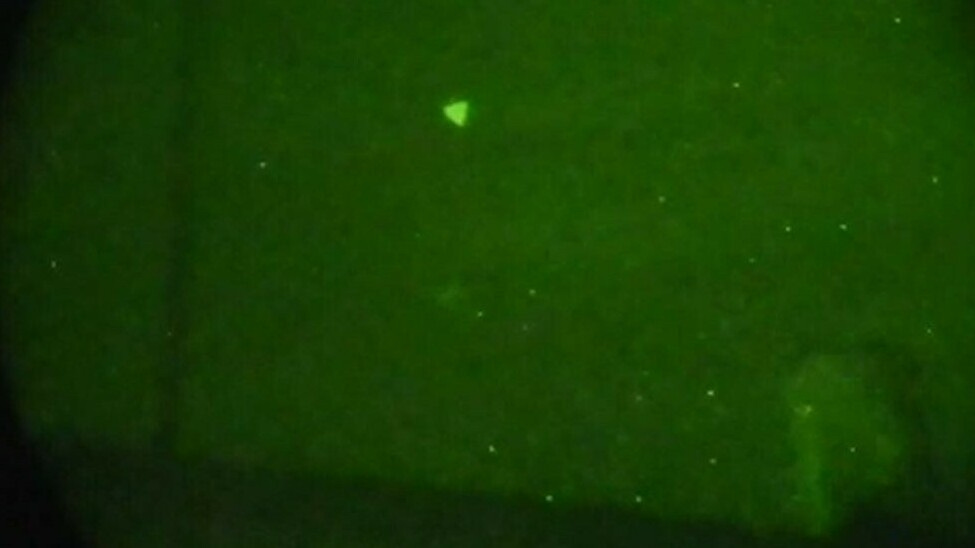Forms of the Unknown: Could UAPs Be Electromagnetic Probes?
Exploring a Plasma Cosmology Perspective on Unidentified Aerial Phenomena: Remote Control, Information Feedback, and Electromagnetic Coupling
“The Pentagon released this image of an Unidentified Aerial Phenomena (UAP) that was later determined to be a drone last year. The U.S. office that investigates UAP received hundreds of reports in 2022. This image was captured through night vision goggles during naval exercises off the U.S. East Coast in early 2022. U.S. Navy.” The Pentagon got hundreds of new reports of UFOs in 2022, a government report says. (Credit: US Navy)
The Shape of Mystery
Unidentified Aerial Phenomena (UAPs) have fascinated and confounded humanity for decades. From bright, darting lights to dark, elusive shapes. Their forms and their behaviours have defied traditional explanations. These enigmatic objects come in a variety of shapes, too. Spheres, triangles, discs, and elongated forms. And even the famous “tic-tac”. Could these mysterious objects be understood through the lens of plasma cosmology and the Electric Universe theory? Let’s embark on a thought experiment to explore the possibility that UAPs are advanced, electromagnetic probes built not by chance but by design.
Electromagnetic Shapes on a Cosmic Thread
Imagine a variety of UAP shapes, smooth metallic discs, elongated objects, or triangular forms, hovering effortlessly in Earth’s atmosphere. Traditional theories suggest propulsion systems, computing hardware, and navigation technologies. But what if none of these are required? In the Electric Universe framework, where electromagnetic forces govern much of the cosmos, these objects might be manifestations of plasma physics rather than mechanical engineering.
Shapes like spheres and discs are ideal for minimizing energy loss and maintaining uniform electromagnetic fields. While elongated or triangular forms might enhance specific resonances or directional stability. If these objects are fundamentally electromagnetic in nature, they could resonate with Earth’s magnetosphere, the Sun’s heliosphere, and even the galactic current that threads through interstellar space. This resonance could enable them to “tap into” these vast energy systems for both movement and communication.
Decoding the Invisible: Are Dark UAPs Cold Plasma?
UAPs aren’t always flashy. Many sightings describe “Dark UAPs”. They are difficult to detect because of their low reflectivity or emitted light. A paper by Boris Zhilyaev et al. explores the characterization of these dim objects. He suggests that their elusive nature might stem from physical properties rather than mere stealth technology.
In plasma cosmology, the distinction between “cold plasma” and “warm plasma” is crucial. Cold plasma, with low ionization levels, emits little light, making it appear “dark.” Warm plasma, on the other hand, glows brightly due to higher ionization and energy states. Could “Dark UAPs” be cold plasma phenomena, dimming their visibility by altering their charge states? This dynamic brightening and dimming might explain why UAPs sometimes appear to vanish into thin air.
Information Nodes in the Electric Universe
Now consider these UAPs not as vehicles but as probes. Remote sensors that collect and transmit data. In this model, the UAPs act as electromagnetic nodes in a vast feedback loop. It is constantly interacting with the Sun’s, Earth’s, and interstellar electromagnetic fields.
Here’s how it might work:
The UAP’s magnetic field couples with environmental electromagnetic fields and resonates with the ambient energy.
This coupling allows the UAP to “read” information encoded in electromagnetic waves and include environmental changes and atmospheric conditions. And possibly even residual data from past events.
The gathered information is processed by the UAP’s electromagnetic structure. Then it is transmitted back to a remote controller via oscillations.
This approach eliminates the need for onboard computing systems, cameras, or sensors. Instead, the UAP operates as a pure electromagnetic interface. One with an advanced AI on the receiving end, decoding the transmissions and converting them into usable data. Potentially as visual or auditory representations.
Propulsion Beyond Physics Textbooks
One of the most baffling aspects of UAPs is their movement. Instantaneous accelerations, abrupt directional changes, and silent operation seem to defy conventional physics. But what if these behaviours are byproducts of electromagnetic propulsion?
In this scenario, the UAPs draw energy directly from the Sun’s heliosphere, Earth’s global electric circuit, or the galactic current. Electromagnetic forces provide propulsion. They allow the objects to move without inertia, friction, or the need for chemical fuel. This could explain their seamless transitions between Earth’s atmosphere, outer space, and beyond.
Probes Without Time Limits
A particularly intriguing aspect of this hypothesis is the durability of these probes. With no moving parts, no organic systems, and no reliance on traditional computing hardware, UAPs would be immune to many environmental hazards:
Galactic radiation would pose no threat. Their electromagnetic nature would allow them to adapt to high-energy fields.
Extreme temperatures, pressures, and biosphere incompatibilities would be irrelevant to their operation.
If extraterrestrial in origin, UAPs could function for millennia, transmitting data across interstellar distances with minimal degradation. This endurance makes them ideal tools for exploring the vastness of space.
Implications for Understanding UAPs
If UAPs are electromagnetic phenomena, they might represent a synthesis of advanced technology and natural physics. Whether they are extraterrestrial probes, artifacts of a higher intelligence, or even natural plasma formations, this perspective shifts the focus from propulsion systems and onboard pilots to the dynamics of electromagnetic fields and information transfer.
By examining UAPs through the lens of plasma cosmology and the Electric Universe theory, we not only gain new tools to understand their behaviours. We also open the door to rethinking our relationship with the cosmos. Are these phenomena mere curiosities, or could they be glimpses into an advanced understanding of electromagnetic energy? Could it be a universal language of the stars?
Layers of Mystery: Could the Buga Sphere Be an Electromagnetic Probe?
“In my opinion, if this sphere is legitimate, it might not be a piece of technology but rather something controlled by a higher consciousness—or by light, plasma, an orb, or the Tibetan rainbow body. Now that the 'spirit' has left, it is just an ordinary object.”
References:
Zhilyaev, Boris E., et al. "Unidentified Aerial Phenomena: Characterization of Dark UAPs." Astronomical Society Reports, 2021.
Peratt, Anthony L. "Physics of the Plasma Universe." Springer Science & Business Media, 2015.
Alfven, Hannes. "Cosmic Plasma." Astrophysics and Space Science Library, 1981.
Thornhill, Wallace, and David Talbott. "The Electric Universe." Mikamar Publishing, 2007.
Gurnett, Donald A., and Amitava Bhattacharjee. "Introduction to Plasma Physics: With Space and Laboratory Applications." Cambridge University Press, 2005.




